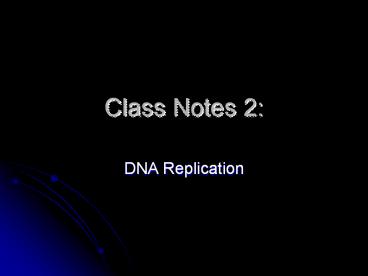Class Notes 2: PowerPoint PPT Presentation
Title: Class Notes 2:
1
Class Notes 2
- DNA Replication
2
Replication Process
A-T-C-G-G-T-A-T-A-C-C-G-C-T-A-T
T-A-G-C-C-A-T-A-T-G-G-C-G-A-T-A
3
Replication Process
A-T-C-G-G
-T-A-T-A-C-C-G
T-A-G-C-C
-A-T-A-T-G-G-C
Enzyme
4
Replication Process
A-T-C-G-G
-T-A-T-A-C-C-G
T-A-G-C-C
-A-T-A-T-G-G-C
5
Replication Process
A-T-C-G-G
-T-A-T-A-C-C-G
T-A-G-C-C
-A-T-A-T-G-G-C
6
Replication Process
A-T-C-G-G
-T-A-T-A-C-C-G
T-A-G-C-C
-A-T-A-T-G-G-C
7
Replication Process
A-T-C-G-G
-T-A-T-A-C-C-G
T-A-G-C-C
-A-T-A-T-G-G-C
8
Replication Process
-T-A-T-A-C-C-G
A-T-C-G-G
T-A-G-C-C
-A-T-A-T-G-G-C
9
Replication Process
-T-A-T-A-C-C-G
A-T-C-G-G
T-A-G-C-C
-A-T-A-T-G-G-C
10
Replication Process
-T-A-T-A-C-C-G
A-T-C-G-G
T-A-G-C-C
-A-T-A-T-G-G-C
11
Replication Process
-T-A-T-A-C-C-G
A-T-C-G-G
T-A-G-C-C
-A-T-A-T-G-G-C
12
Replication Process
-T-A-T-A-C-C-G
A-T-C-G-G
T-A-G-C-C
-A-T-A-T-G-G-C
13
Replication Process
-T-A-T-A-C-C-G
A-T-C-G-G
T-A-G-C-C
-A-T-A-T-G-G-C
14
Replication Process
-T-A-T-A-C-C-G
A-T-C-G-G
T-A-G-C-C
-A-T-A-T-G-G-C
15
Replication Process
-T-A-T-A-C-C-G
A-T-C-G-G
T-A-G-C-C-A-T-A-T-G-G-C
A-T-C-G-G-T-A-T-A-C-C-G
T-A-G-C-C
-A-T-A-T-G-G-C
16
I. Why does DNA replicate?
- Every new cell needs its own DNA.
- Must be identical to original.
- Occurs during interphase, before mitosis.
17
II. Replication
- A. Step 1-
- The hydrogen bonds holding the base pairs
together are broken and the DNA unzips into 2
separate single strands.
18
B. Step 2 of Replication
- As the DNA is unzipping, each strand becomes a
template. - Free nucleotides from the cell match with the
corresponding base pair. They are bonded by DNA
polymerase.
19
C. Step 3 of Replication
- Replication produces 2 new single strands, each
connected to one original strand. - Since one strand is conserved in each new
molecule of DNA, this is called semi-conservative
replication
20
Summary
- List the steps of replication. Why is replication
necessary?
PowerShow.com is a leading presentation sharing website. It has millions of presentations already uploaded and available with 1,000s more being uploaded by its users every day. Whatever your area of interest, here you’ll be able to find and view presentations you’ll love and possibly download. And, best of all, it is completely free and easy to use.
You might even have a presentation you’d like to share with others. If so, just upload it to PowerShow.com. We’ll convert it to an HTML5 slideshow that includes all the media types you’ve already added: audio, video, music, pictures, animations and transition effects. Then you can share it with your target audience as well as PowerShow.com’s millions of monthly visitors. And, again, it’s all free.
About the Developers
PowerShow.com is brought to you by CrystalGraphics, the award-winning developer and market-leading publisher of rich-media enhancement products for presentations. Our product offerings include millions of PowerPoint templates, diagrams, animated 3D characters and more.

